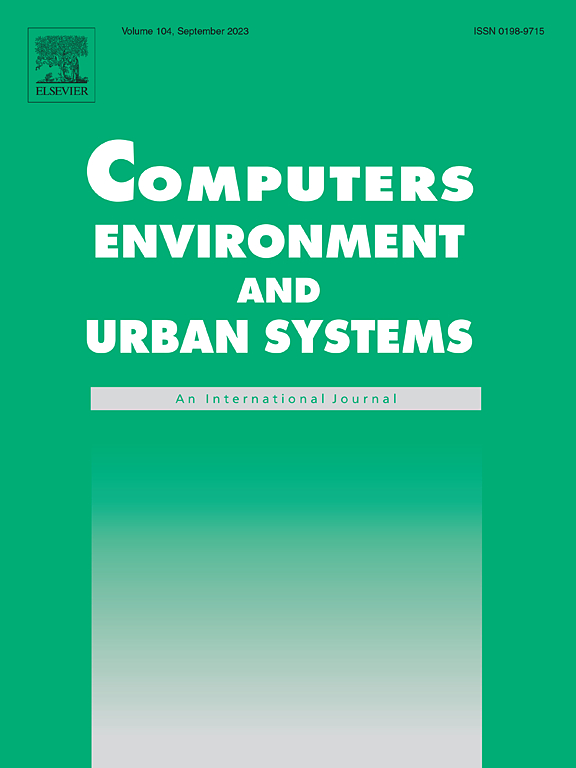根据ChatGPT的城市吸引力:对比人工智能和人类的见解
IF 8.3
1区 地球科学
Q1 ENVIRONMENTAL STUDIES
Computers Environment and Urban Systems
Pub Date : 2024-12-24
DOI:10.1016/j.compenvurbsys.2024.102243
引用次数: 0
摘要
城市环境的吸引力显著影响居民对其居住空间的满意度和整体情绪,进而影响他们的健康和福祉。考虑到通过居民调查或询问收集城市吸引力评估的资源密集型性质,人们不断寻求自动化解决方案来简化这一过程并支持空间规划。在这项研究中,我们使用了一个现成的人工智能模型来自动分析城市吸引力,使用了芬兰赫尔辛基1800多万张街景图像。通过结合GPT-4模型,我们通过三个基于标准的提示来评估这些图像。同时,24名参与者,分为居民和非居民,被要求对这些图像进行评价。为了深入了解GPT-4的非透明决策过程,我们采用语义分割来探索模型如何使用不同的图像特征。我们的研究结果表明,GPT-4和参与者评分之间存在很强的一致性,尽管存在地理差异。具体来说,GPT-4显示出对拥有大量绿色植物的郊区的偏好,与发现这些地区不那么吸引人的参与者形成鲜明对比。相反,在赫尔辛基市中心和人口密集的城区,GPT-4给出的吸引力分数低于参与者的评分。语义分割分析表明,GPT-4的评分主要受植被、建筑物和人行道等物理特征的影响。虽然人工智能和人类在不同地点的评估是一致的,但GPT-4努力将上下文的细微差别纳入其评级,不像参与者那样考虑城市环境的背景和特征。该研究表明,利用像GPT-4这样的人工智能模型,空间规划者可以有效地收集对不同区域吸引力的见解。然而,谨慎是必要的,当我们使用现成的模型时,开发专门训练以理解本地上下文的模型是至关重要的。尽管人工智能模型提供了有价值的见解,但人类的视角对于全面理解城市吸引力至关重要。本文章由计算机程序翻译,如有差异,请以英文原文为准。

Urban attractiveness according to ChatGPT: Contrasting AI and human insights
The attractiveness of urban environments significantly impacts residents' satisfaction with their living spaces and their overall mood, which in turn, affects their health and well-being. Given the resource-intensive nature of gathering evaluations on urban attractiveness through surveys or inquiries from residents, there is a constant quest for automated solutions to streamline this process and support spatial planning. In this study, we applied an off-the-shelf AI model to automate the analysis of urban attractiveness, using over 1800 Google Street View images of Helsinki, Finland. By incorporating the GPT-4 model, we assessed these images through three criteria-based prompts. Simultaneously, 24 participants, categorised into residents and non-residents, were asked to rate the images. To gain insights into the non-transparent decision-making processes of GPT-4, we employed semantic segmentation to explore how the model uses different image features. Our results demonstrated a strong alignment between GPT-4 and participant ratings, although geographic disparities were noted. Specifically, GPT-4 showed a preference for suburban areas with significant greenery, contrasting with participants who found these areas less attractive. Conversely, in the city centre and densely populated urban regions of Helsinki, GPT-4 assigned lower attractiveness scores than participant ratings. The semantic segmentation analysis revealed that GPT-4's ratings were primarily influenced by physical features like vegetation, buildings, and sidewalk. While there was general agreement between AI and human assessments across various locations, GPT-4 struggled to incorporate contextual nuances into its ratings, unlike participants, who considered both context and features of the urban environment. The study suggests that leveraging AI models like GPT-4 allows spatial planners to gather insights into the attractiveness of different areas efficiently. However, caution is necessary, while we used an off-the-shelf model, it is crucial to develop models specifically trained to understand the local context. Although AI models provide valuable insights, human perspectives are essential for a comprehensive understanding of urban attractiveness.
求助全文
通过发布文献求助,成功后即可免费获取论文全文。
去求助
来源期刊

Computers Environment and Urban Systems
Multiple-
CiteScore
13.30
自引率
7.40%
发文量
111
审稿时长
32 days
期刊介绍:
Computers, Environment and Urban Systemsis an interdisciplinary journal publishing cutting-edge and innovative computer-based research on environmental and urban systems, that privileges the geospatial perspective. The journal welcomes original high quality scholarship of a theoretical, applied or technological nature, and provides a stimulating presentation of perspectives, research developments, overviews of important new technologies and uses of major computational, information-based, and visualization innovations. Applied and theoretical contributions demonstrate the scope of computer-based analysis fostering a better understanding of environmental and urban systems, their spatial scope and their dynamics.
 求助内容:
求助内容: 应助结果提醒方式:
应助结果提醒方式:


